Driving Culture and Standards in Saudi Arabia
Christmas in Saudi Arabia, part co-six (27th December 2024)
As the 27th December was Friday, meaning two things: 1) ‘twas the local holiday and time-off and 2) a guarantee that most sites would be closed. That’s why we spent most of the day doing sightseeing from the car. This is also why today’s post will be a little bit different, as beside describing the day I wanna talk about the local habits concerning vehicle traffic.
A special shout out and dedication goes to my dad, who was first in my entourage to discover the beauty of Arabian driving style and
, who I can assure his disinterest in ever driving a car in Saudi Arabia (expressed in a response to my comment from below) was fully justified. My take is it’s not for everyone, but best way of finding out is experiencing it for yourself.At least you'll have a long-lasting memory of those lanes, just like my dad has from driving in Saudi Arabia (he's frequently flying there due to his current job). He told me many times (and showed some pictures) how they have there many interesting features, for example speed bumps that reqire slowing down almost to zero, otherwise the suspension wil be broken, as well as insane driving habits, such as fitting five cars across three lanes or having little to no driving courtesy, which shows in not letting pedestrians by or letting in those joining from the subordinate roads. It appears from his stories KSA is a totally different driving world.
(…)
replied: I definitely don't have what it takes to drive in Saudi Arabia. I'd have a nervous breakdown just pulling out of the parking lot.It can be nerve-wrecking at first for unaccustomed. But we’ll get to that shortly. The day truly began after we’ve packed everything into the car and drove off from the hotel. Taking advantage of smaller traffic due to Friday being a holiday according to the local laws, habits and traditions, we took a stroll-drive through the corniches of Khobar, Dammam and Ras Tanurah. The streets were almost empty, rarely a car passed by, and the mini buses that take the workers to construction sites were nowhere to be seen, except one or two being stranded on a little flat square or unguarded car park. Alike was the situation with the school buses.
And so, clinging to the shores of the Gulf we reached a headland, from which there was a view on the Dammam harbour and surroundings. We strolled through a picturesque promenade, taking pictures and petting stray cats (which made us miss ours a little). On the inside we had a recreational area, where whole families were relaxing on their day off.
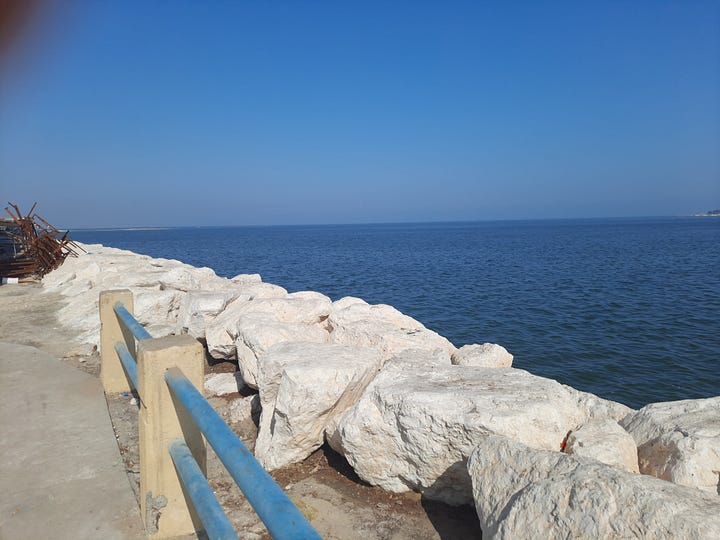
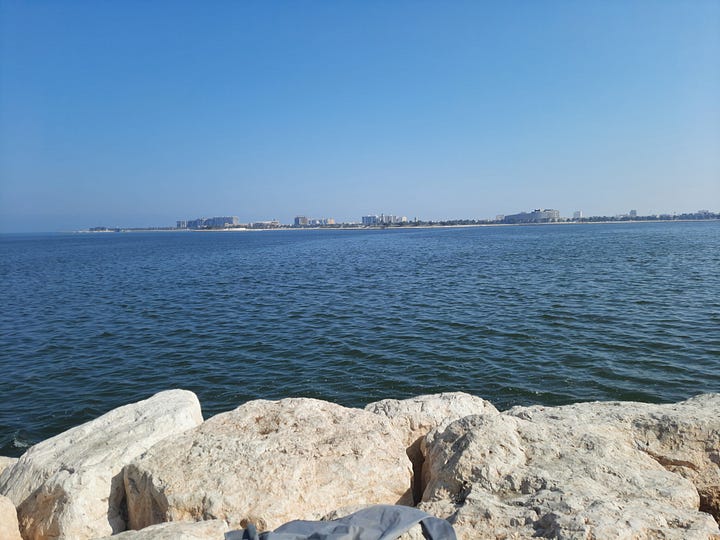
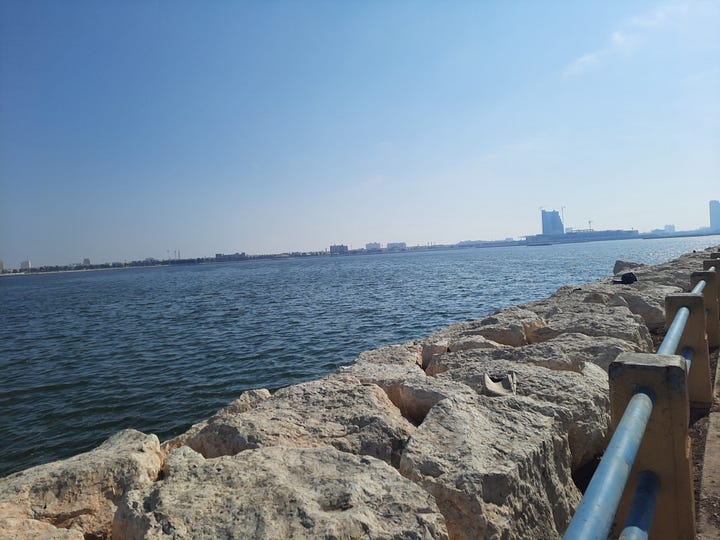
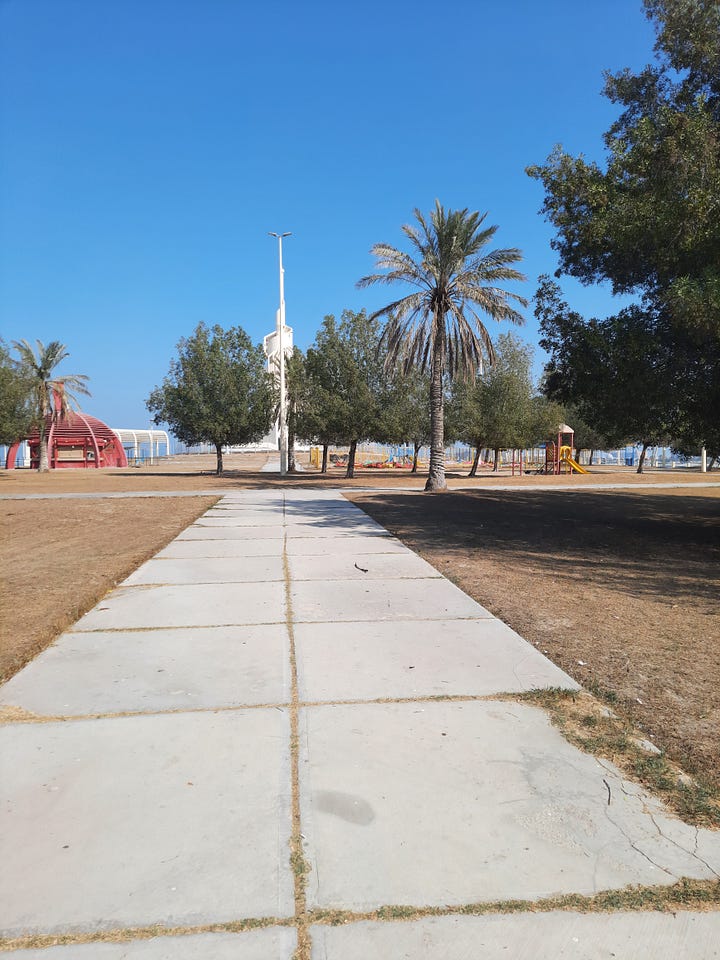
We finished this short walk, returned to the car and drove north to a place called Mangrove Park. That was a place for growning and preserving Mangrove funded and build by Saudi Aramco. It consisted of few closed greenhouses for cultivating that plant and a sightseeing part which was in the shape of a walking platform reaching few hundred meters into lichens and shrubs. The entrance was marked by the sole building in the area which had inside toilets, hall, information point with monitoring and security, science exhibition in the shape and form of info-boards, aquarium and self-checkout shop. Especially the last one caught our attention for longer, because there was a nice little surprise waiting to be spotted. The shop was in fact a shelf with a card terminal placed on top of it for self-checkout, the goods there being sweets. Among these to our enjoyment were few chocolate bars of our domestic production! In a long time seeing the “Grześki” mark hasn’t been such a joyful sight. For this reason, I have documented the distant export tentacles of our confectionery industry in the photos.
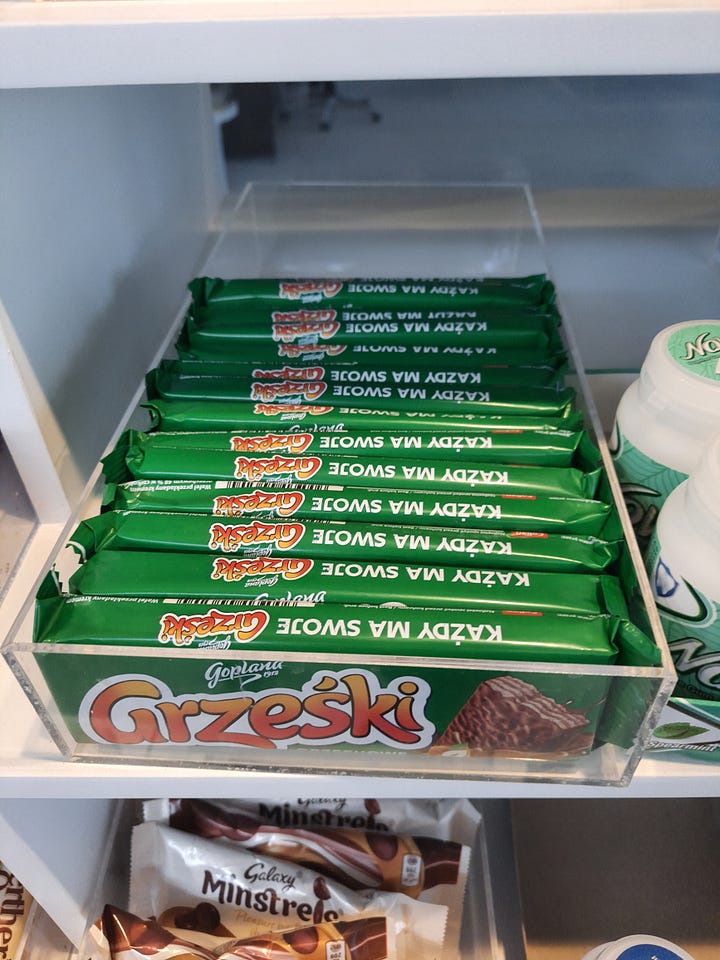
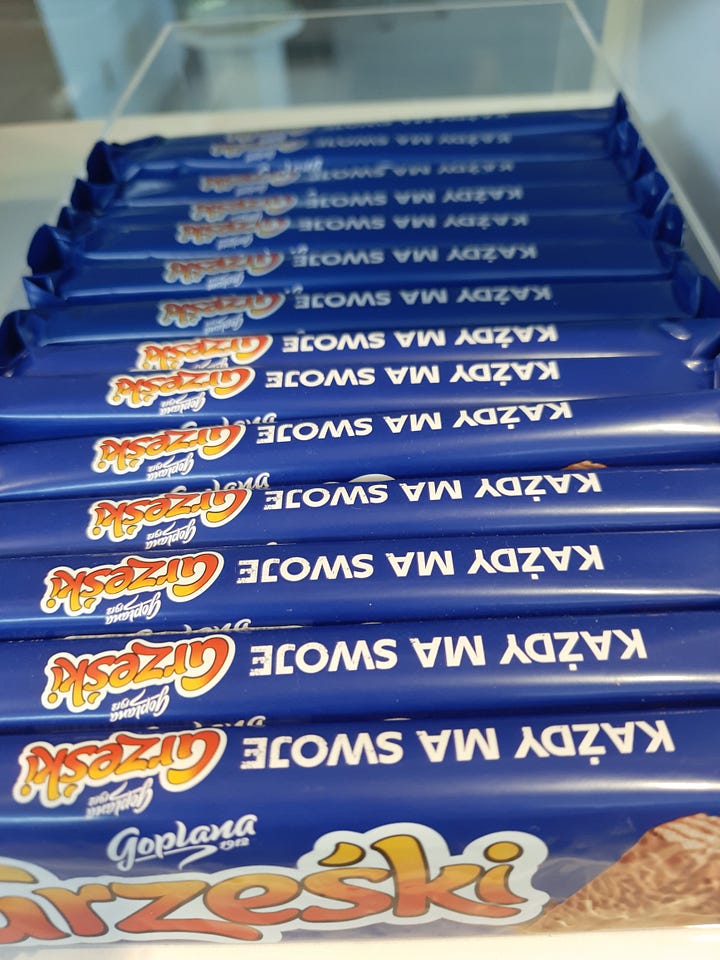
After exiting the building we headed for the platform among the bushes. The hike to the viewpoint at the end of the route took us few minutes, interrupted by passing other tourists and admiring the crabs rummaging through the reeds and sand. At the end we looked around and returned to the banking, then spend a moment on observing the view from the roof terrace through binoculars installed there. When we decided we were done, we came back en route of our drive.


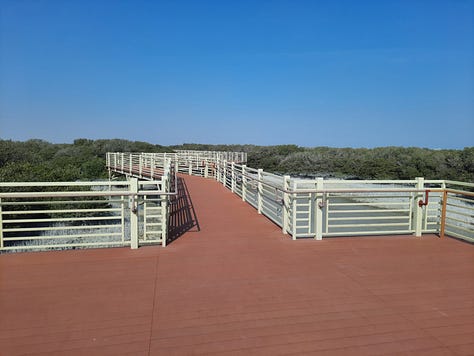



To bid farewell to the Persian Gulf and Easter Province area we visited from a car perspective some places linked with dad’s early steps in Saudi Arabia. We drove to the city of Ras Tanurah to see the employees’ villa, where the firm’s personnel lives while supervising the projects conducted in the region (the inside we saw multiple times on videochats) plus a location vital for the company’s development - a farm called Chicken Ranch, which was the site of their first won and delivered project. Bof of these places were in areas with lesser traffic, hidden from rush avenues and wobbly speed bumps.
Finally it was time for returning to Riyadh. The highways took us through the desert, which which shimmered with many shades of yellow and beige. If you are setting to be a future user of saudi roads, here are few pointers for you. The speed limits are 100, 120 and 140 km/h, depending on the vehicle’s size and terrain conditions. Assuming you’ll be able to decipher the road signs, as less representative areas aren’t putting also common (here called “western”) numerals, but only local (“Arab” per se). But be warned you who’d dare to breach them - major routes are evenly covered with speed cameras (examples below). And they aren’t brightly marked as those in Poland, but masked to resemble for example thrown away air conditioner or fancy road lamp. Sometimes, cameras set up guerrilla-style, on the side of the road as if a documentary was being shot there, catch the driver. Beware of them, road madness enthusiasts - not only for road piracy, but also driving without a seat belt or with a phone in your hand will be tracked down and will bring a hefty ticket (dad once made an inglorious double when starting from a street parking lot - seat belt and phone). Although speeding fines are still small compared to tickets for driving on red light - 3000 SAR is not an easy feat!
Beware also those faster than you - they will announce their intention to overtake you by driving at your bumper and by driving with drivers who are much more aggressive than their Polish counterparts. They will pass by on the left, right, and even roadside if the standard three-lane road gets too narrow. Truckers will tend to keep to the right, although they will also sometimes have to overtake or transport loads that extend beyond the width of the lane. For this reason, and because some people randomly go off-road, it is recommended to avoid the right lane and drive in the middle or left one. When you come across a slower car, demonstrate by driving at their bumper so that they can let you pass, otherwise they won't understand your intentions. Despite it often getting nervous, the roads here are calmer than even few years ago, when folks were more risky behind the wheel.

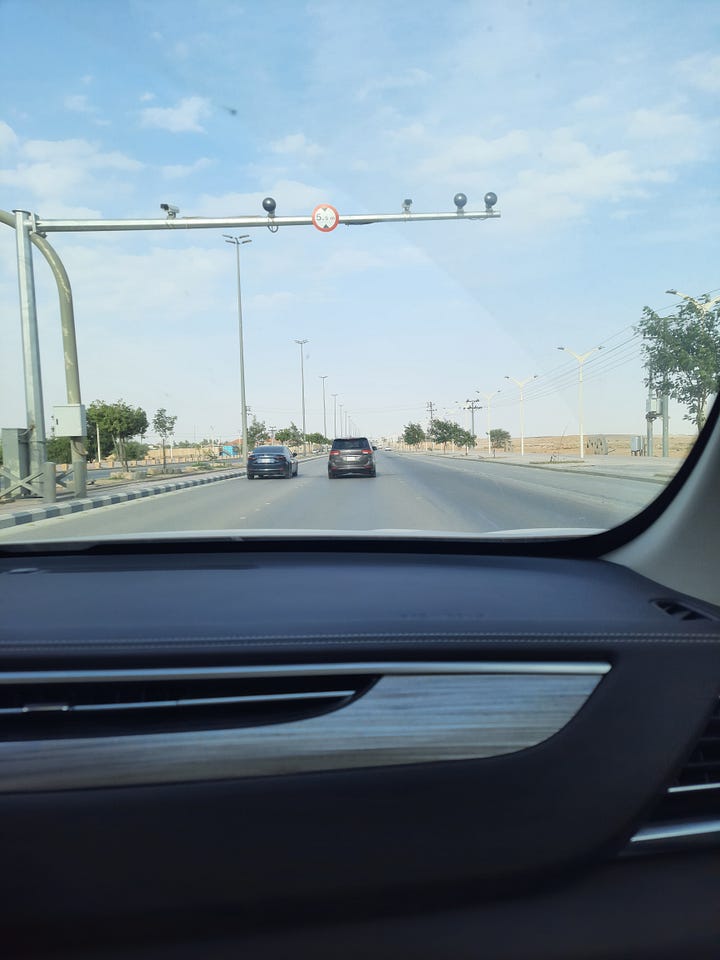

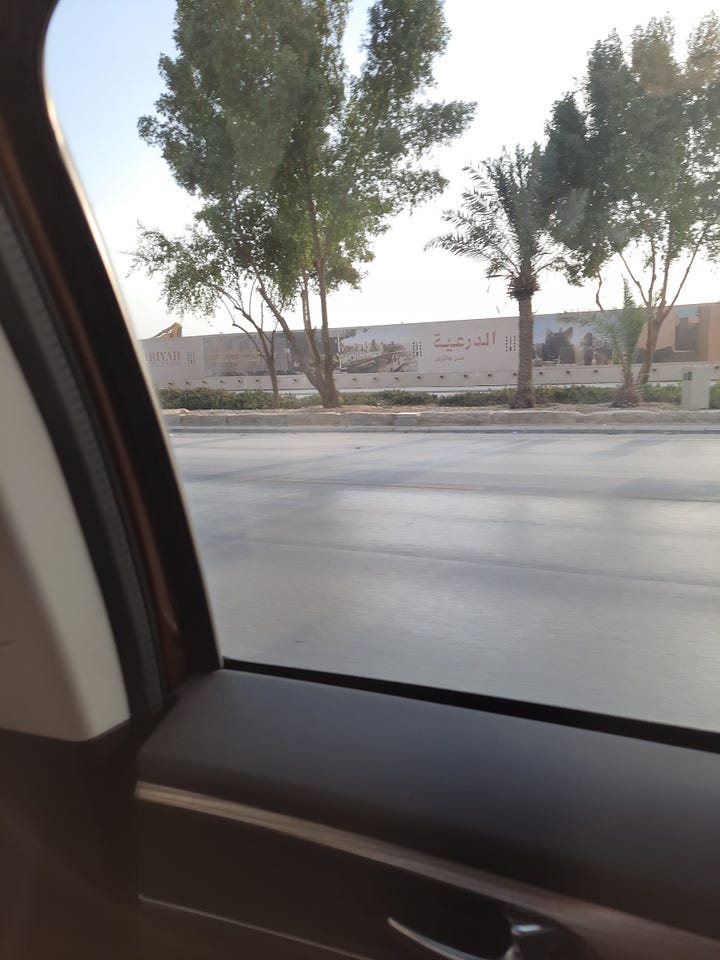
Near the checkpoints calm driving and avoiding catching attention of the guards is advised. The police is playing the referee in deductiong who was at fault. Woe to you if you try to discuss with them - they are not there to do so. Ultimately we saw only one car accident, a light crash and drivers waiting for tha arrival of uniformed officers. There are more incidents like car scrapes/scratches, the sight of a car with scars or large dents in the bodywork is not unusual here. Still, it's better not to hook anyone, because they are so inclined to chase you until they get satisfaction, just like that Arab chasing the Hindu guy the day before. In the cities, a common sight is five columns on three lanes of traffic, with absolutely no regard for pedestrians, which is why it is better to avoid crossings without lights. On the other hand, people often lie around carelessly, which is also something to remember. Another point is to never, ever underestimate the speed bumps - they are there steep and would rip off your suspension at more than fer kph. Also forget about being let from subordinate road - such courtesy is a rare sight here. In traffic you must have eyes around your head, especially on motorbikes that drivers are aware of even rarlier than in Poland. In general, the lack of decisiveness and quick choice of maneuvers is costly here on nerves and often on the wallet.
The time for dinner caught us just when we were about to go to the service area to refuel. Such sites are consisting beside a gas station of car service, wash, tyre shop, few fast foods and travellers’ mosque, like Autobahnkirche, the German Motorway Church. This is why I think the Aussies’ word Servo describes those places in Arabia best. One can here eat, nourish the car, refuel and pray in times mandated by Quran. The pumps on the stations are operated by immigrants (their labour is cheaper for Saudis than installing self-checkout, same for automatic car washes), to whom you should tell the type of fuel and how much you need, as well as the method of payment. Most often you do it with a formula similar to this one:
Hello. Ninety-One. Full. [No] Fattura. MasterCard OK?
There are three types of fuel available: 91 & 95 unleaded plus diesel. The prices are state-regulated and identical on all petrol stations. Recently there were increases, hence for the types above the cost is respectively “expensive” (by local standards): 2.18 SAR, 2.33 SAR and 1.16 SAR (hardly anyone drives diesel, and a month after our visit the price rose to 1.66). Most people opt for full tank. “Fattura” is a false friend, because it means receipt, not invoice. Asking for the possibility of card payment is slowly getting obsolete, but there are some stations where crew doesn’t have terminals.
We ate the dinner in a Pakistani restaurant recommended by dad. The food was tasty, though spicy. Then we walked through the car parking and near the mosque, which beside the crescents was easily recognisable by shoes left in front of the entrance. Saudi Arabs most commonly drive Asian brands (reigning is Toyota, Honda, Nissan and chinese manufacturers) and American ones (mainly Chevrolet, Cadillac, GMC and Ford). European marques, especially the German ones are here a luxurious rarity. Hence dad’s bragging that we and majority in Poland are driving Audi, BMW and Volkswagen cars earns him more prestige in the partners’ eyes.
It was evening when we reached the same hotel we stayed in previously and unpacked our stuff. Our supper consisted of junk food from local market, so we went to one at the edge of a representative promenade to buy snacks & drinks. Then we went for another stroll to the city center and back. We passed by restaurant gardens full of people watching games of the 2026 World Cup qualifiers and crowds of walkers, mainly youth and families with children. We headed westwards until a group of buildings visually resembling downtown of our capital city, which we called “Little Warsaw”.
During the walk there was one detail that fled my attention, which dad and Antek were kinde to point out to me before going to bed. They said my silhouette and outfit were drawing interest from gals out there, for whom according to my relatives I was looking attractive. It was surprising to me, but I didn’t think much about it for a time being.




